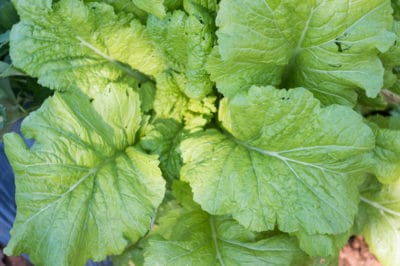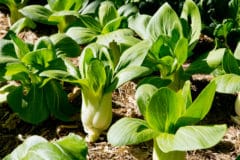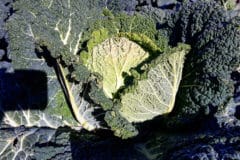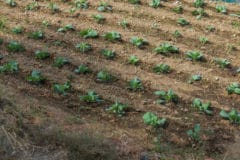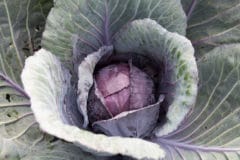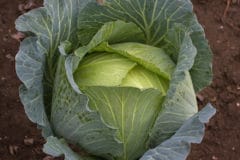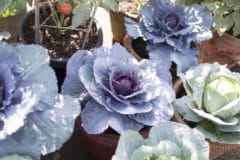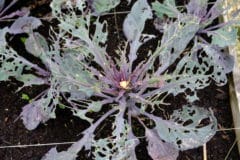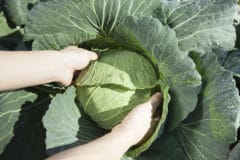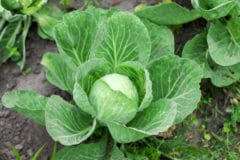Sowing Napa Cabbage
Although Napa cabbage doesn’t look anything like the familiar round heads of green cabbage, the two are so closely related that their growing requirements are nearly identical. They even share the same pests.
Choosing a Location for Planting
Napa cabbage likes a patch with full to partial sun. For early spring planting when temperatures are cooler, full sun is best. When temperatures warm up, however, Napa cabbage will do better in a cooler spot that is partially shaded during the heat of the day. Even in partial shade, though, the space you choose should receive at least four to five hours of sunlight each day.
The site you choose should be well-drained. It should not be a site where water collects at the surface or where the upper level of the soil remains muddy for extended periods. The top 5 to 6 inches below the surface should remain moist, though. You can always improve moisture retention by adding a 2-inch thick layer of mulch around your cabbages.
The soil where you plant your cabbage should be loamy or sandy but also rich with organic materials. The pH level should be between at least 6.5 and 6.8. If testing reveals that your soil needs improving, or amending, you can work a 3 inch layer of compost into the top 6 inches of the soil, or add a 20-20-20 organic fertilizer.
To prevent recurring infestations of pests and diseases, avoid planting your Napa cabbage in a space where you have planted cabbage or related plants like kale, broccoli, Brussels sprouts, mustard, cauliflower, or collards.
Choosing a Time for Planting
Napa cabbage can withstand hard frosts at temperatures as low as 28°F (-2°C), so you can plant it in the early spring.
While Napa cabbage is a biennial that shouldn’t bolt, or go to seed, in it’s first year, the change from cold to warmer weather in the spring could fool your cabbages into thinking that they have overwintered and that it’s time to form seeds.
If you want an early spring harvest, reduce the chance of bolting by starting your seeds indoors in biodegradable peat or paper pots or in the cut down cardboard tubes from toilet paper rolls. These tubes double as a protective collar that discourages cutworms and root maggots.
Start your seeds six to eight weeks before the last frost date in your area, and begin acclimating them to the conditions outdoors about two weeks before you intend to transplant them.
You can transplant your cabbages as early as two to three weeks before the last frost date in your area, but if you wait until after the first frost date, they are less likely to experience a sudden change from cold to warm weather that could cause them to bolt.
If you plan to sow your cabbage seeds directly into your garden, you can do so as early as two weeks before the last frost date in your area, but again, waiting until after the first frost date reduces the risk of bolting.
For a fall harvest, sow your seeds in your garden in mid- to late summer after temperatures have cooled to 75°F (24°C).
If you don’t have space for a garden, you can grow Napa cabbage in containers that allow 12 to 18 inches per cabbage.
Spacing Your Cabbages
You should plant enough Napa cabbage to have six to eight plants per person in your household. Allow extra to account for guests, thinning the plants, and cabbages that fall victim to pests or disease.
- Plant your seeds 6 inches apart and cover them with 1/2 inch of soil.
- When your cabbages are about 2 inches tall, thin them to 12 to 18 inches apart.
- Transplanted cabbages also should be spaced 12 to 18 inches apart.
Growing Napa Cabbage
Once you have your Napa cabbage growing in your garden, you will need to keep it healthy by protecting it from pests and providing it with sufficient water and nutrients. If any plants should fall victim to a disease, pull it up with the roots and discard immediately. Don’t add it to your compost.
Protecting Napa Cabbage From Pests
Delaying spring planting not only reduces the risk of bolting but also protects your cabbage from hungry caterpillars like the cabbage loopers and cabbage worms that emerge in the spring ready for a feast.
Row covers prevent the moths of these caterpillars from reaching your cabbages to lay their eggs. The caterpillars and their eggs also can be removed by hand. Drop the caterpillars in a bucket containing a mixture of water and dishwashing liquid.
Aphids can be flicked off with a blast of water from a hose. Aphids have weak legs and are unlikely to be able to climb back up your cabbages.
If you spread diatomaceous earth around the base of your cabbages, it will pierce soft-bodied pests like aphids and caterpillars, killing them.
Organic treatments such as bacillus thuringiensis or homemade tomato leaf spray also control pests.
Companion plants such as nasturtiums lure aphids away from your cabbages while thyme repels the imported white cabbage moth and tansy repels cutworms and the imported cabbageworm.
Watering Napa Cabbage
Napa cabbage needs 1 inch of water per week. Supplying spring-planted Napa cabbage with sufficient water is another way to discourage bolting. Providing any type of headed cabbage with a steady supply of water also prevents growth spirts that can result in splitting cabbage heads.
Using a soaker hose keeps the leaves from getting wet and helps prevent diseases like black leg, a fungus that appears on the stalk and leaves, and black rot which results in foul smelling black veins on the leaves.
Fertilizing Napa Cabbage
When your cabbages begin to form heads, apply a side dressing of compost or a nitrogen rich organic fertilizer such as soy meal or fish emulsion. Reapply fertilizer every three weeks throughout the growing season. Cabbages draw a lot of nutrients from the soil, and fertilizing them regularly prevents fusarium yellows, although Napa cabbage is resistant.
Side dressing simply means spreading the compost or applying the fertilizer around the base of the cabbage.
Harvesting Napa Cabbage
When the heads feel firm and resistant when you squeeze them, they are ready to harvest. Simply use a sharp knife to cut them off the stalk at the base of the head. Pull the stalk up with the roots to discourage pests and disease.
You can store the unwashed heads in plastic bags in your refrigerator for up to three weeks, or you can store your cabbage on a bed of straw in a cool root cellar for up to three months. The flavor of cabbage stored in the refrigerator will become stronger the longer it is stored, so plan in advance for how you might want to use it.
